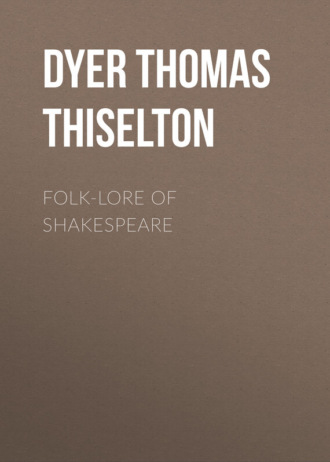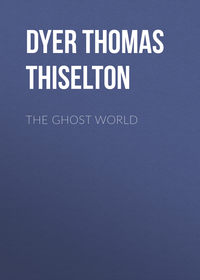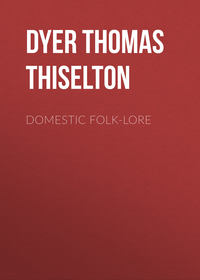 полная версия
полная версияFolk-lore of Shakespeare
633
Liber Secundus – “De Febribus,” p. 923, ed. 1595.
634
Nares’s “Glossary,” vol. ii. p. 906.
635
See 4th series, vol. x. pp. 108, 150, 229, 282, 356.
636
See Dyce’s “Shakespeare,” vol. vii. p. 239.
637
“The Medical Knowledge of Shakespeare,” 1860, pp. 1-64.
638
“The England of Shakespeare,” E. Goadby, 1881, p. 153.
639
“Critical Essays on the Plays of Shakespeare,” 1875, p. 145; see Singer’s “Shakespeare,” vol. iii. pp. 347, 348.
640
See “British Popular Customs,” p. 473.
641
“Notes and Queries,” 6th series, vol. i. p. 129.
642
Cf. “As You Like It” (i. 2). Touchstone alludes to a “certain knight, that swore by his honour they were good pancakes.”
643
See Hone’s “Every Day Book,” 1836, vol. i. p. 258; “Book of Days,” vol. i. p. 239; see, also, Dekker’s “Seven Deadly Sins,” 1606, p. 35; “British Popular Customs,” pp. 62-91.
644
“Notes and Queries,” 1st series, vol. xii. p. 297.
645
See Nares’s “Glossary,” vol. i. p. 443; Brand’s “Pop. Antiq.,” 1849, vol. i. p. 101. Taylor, the Water-Poet, has a tract entitled “Jack-a-Lent, his Beginning and Entertainment, with the mad Prankes of Gentlemen-Usher, Shrove Tuesday.”
646
Singer’s “Shakespeare,” vol. vi. p. 219.
647
“Notes and Queries,” 4th series, vol. v. p. 595.
648
See Singer’s “Shakespeare,” vol. i. p. 362; Nares’s “Glossary,” vol. i. p. 164: Brand’s “Pop. Antiq.,” 1849, vol. iii. p. 94.
649
See Hone’s “Every Day Book,” vol. i. p. 318; “British Popular Customs,” pp. 110-113.
650
St. Patrick rids Ireland of snakes; see p. 257.
651
Singer’s “Shakespeare,” 1870, vol. ix. p. 168.
652
Cf. “Henry V.,” v. 2; “3 Henry VI.,” ii. 1, 2; “Taming of the Shrew,” ii. 1; “Richard II.,” i. 3.
653
Cited by Warton in a note on “Richard III.,” v. 3.
654
Hotten’s “History of Sign-boards,” 1866, 3d ed., p. 287.
655
Cf. “Twelfth Night” (iii. 4): “More matter for a May morning.”
656
“Book of Days,” vol. i. p. 575; see “British Popular Customs,” pp. 228-230, 249.
657
See Brand’s “Pop. Antiq.,” vol. i. pp. 247-270; “Book of Days,” vol. i. pp. 630-633.
658
Nares’s “Glossary,” vol. ii. p. 550.
659
See Drake’s “Shakespeare and his Times,” 1817, vol. i. p. 163.
660
“Encyclopædia of Antiquities,” 1843, vol. ii. p. 653.
661
See “British Popular Customs,” p. 278; Brand’s “Pop. Antiq.,” 1849, vol. i. p. 276.
662
According to the crusaders and the old romance writers a Saracen deity. See Singer’s “Shakespeare,” vol. ix. p. 214.
663
See Dyce’s “Glossary,” p. 482.
664
“Sports and Pastimes,” 1876, pp. 25-28; see Warton’s “History of English Poetry,” vol. ii. p. 202.
665
“Illustrations of Shakespeare,” p. 154.
666
Staunton’s “Shakespeare,” 1864, vol. i. pp. 147, 148.
667
See “Book of Days,” vol. i. p. 712.
668
See Singer’s “Shakespeare,” vol. v. p. 206.
669
See Nichol’s “Collection of Poems,” 1780, vol. iii. p. 204.
670
See Knight’s “Life of Shakespeare,” 1845, p. 71; Howitt’s “Pictorial Calendar of the Seasons,” 1854, pp. 254-267.
671
“Polyolbion,” song 14; see Brand’s “Pop. Antiq.,” 1849, vol. ii. p. 34; Timbs’s “A Garland for the Year,” pp. 74, 75.
672
Introduction to the “Leopold Shakespeare,” p. xci.
673
“Book of Days,” vol. i. p. 816; see Brand’s “Pop. Antiq.,” vol. i. p. 314; Soane’s “Book of the Months.”
674
See Brand’s “Pop. Antiq.,” 1849, vol. i. pp. 336, 337.
675
See “British Popular Customs,” pp. 347-351.
676
Douglas’s “Criterion,” p. 68, cited by Ritson; see Douce’s “Illustrations of Shakespeare,” p. 475.
677
This is, perhaps, a corrupt abbreviation of “By Jesus.” Some would read “By Cis,” and understand by it “St. Cicely.”
678
See Nares’s “Glossary,” vol. i. p. 57; Morley’s “Memoirs of Bartholomew Fair,” 1859.
679
“Illustrations of Shakespeare,” p. 21.
680
Dyce’s “Glossary,” p. 47; Douce has given a representation of this instrument of torture from Millœus’s “Praxis Criminis Persequendi,” Paris, 1541.
681
“Glossary,” vol. i. p. 95.
682
Cf. “1 Henry IV.” (i. 3):
“His chin, new reap’d, Show’d like a stubble-land at harvest-home.”
683
See Brand’s “Pop. Antiq.,” 1849, vol. ii. pp. 16-33.
684
See “British Popular Customs,” pp. 372, 373. In Lincolnshire this day is called “Hally-Loo Day.”
685
See Butler’s “Lives of the Saints.”
686
See Nares’s “Glossary,” vol. ii. p. 868; Brady’s “Clavis Calendaria.”
687
Nich. Harpsfield, “Hist. Eccl. Anglicana,” p. 86.
688
See “British Popular Customs,” p. 404.
689
Puling, or singing small, as Bailey explains the word.
690
See Swainson’s “Weather-Lore,” 1873, pp. 141-143.
691
See “British Popular Customs,” p. 409.
692
See Douce’s “Illustrations of Shakespeare,” p. 25; “The Church of Our Fathers,” by D. Rock, 1853, vol. iii. p. 215; Gent. Mag., 1777, vol. xliii. p. 158; see Nares’s “Glossary,” vol. ii. pp. 601, 602; Brady’s “Clavis Calendaria.”
693
Drake’s “Shakespeare and his Times,” vol. i. p. 198.
694
See Sandy’s “Christmastide, its History, Festivities, and Carols;” also Athenæum, Dec. 20, 1856.
695
His blunder for comedy.
696
See “British Popular Customs,” 1876, pp. 459, 463; Nares’s “Glossary,” vol. ii. p. 943; “Antiquarian Repertory,” vol. i. p. 218.
697
This was a deep draught to the health of any one, in which it was customary to empty the glass or vessel.
698
See Douce’s “Illustrations of Shakespeare,” 1839, pp. 441-449.
699
See “British Popular Customs,” pp. 461, 469, 478, 480.
700
See Brand’s “Pop. Antiq.,” 1849, vol. i. pp. 1-15.
701
See Douce’s “Illustrations of Shakespeare,” p. 383; Brand’s “Pop. Antiq.,” 1849, vol. iii. pp. 44-46, 326.
702
See Napier’s “Folk-Lore of West of Scotland,” 1879, pp. 34-40; Keightley’s “Fairy Mythology;” Brand’s “Pop. Antiq.,” 1849, vol. iii. pp. 73, 74.
703
“Anecdotes and Traditions,” 1839, p. 3.
704
“Shakespeare,” 1875, vol. iv. p. 314.
705
Douce’s “Illustrations of Shakespeare,” 1859, pp. 299, 300; Nares’s “Glossary,” vol. i. p. 160; see Brand’s “Pop. Antiq.,” 1849, vol. ii. pp. 84, 85.
706
“Shakespeare and His Times,” 1817, vol. i. p. 220.
707
On entering into any contract, or plighting of troth, the clapping of the hands together set the seal, as in the “Winter’s Tale” (i. 2), where Leontes says:
“Ere I could make thee open thy white hand, And clap thyself my love; then didst thou utter I am yours forever.”
So, too, in “The Tempest” (iii. 1):
“Miranda.My husband, then? Ferdinand. Ay, with a heart as willing As bondage e’er of freedom: here’s my hand. Miranda. And mine, with my heart in’t.”
708
“The Stratford Shakespeare,” 1854, vol. i p. 70.
709
Knight’s “Stratford Shakespeare,” p. 73.
710
Cf. “King John” (ii. 2):
“King Philip.Young princes, close your hands. Austria. And your lips too; for, I am well assured, That I did so, when I was first assured.”
711
See Nares’s “Glossary,” vol. ii. p. 363; “Archæologia,” vol. xiv. p. 7; Jones’s “Finger Ring Lore,” 1877, pp. 313-318.
712
See Jeaffreson’s “Brides and Bridals,” 1873, vol. i. pp. 77, 78.
713
Sops in wine.
714
See “Brand’s Pop. Antiq.,” 1849, vol. ii. pp. 136, 139.
715
“Pop. Antiq.,” vol. ii. p. 140.
716
“Brides and Bridals,” 1873, vol. i. p. 252.
717
“Brides and Bridals,” vol. i. p. 177.
718
See Brand’s “Pop. Antiq.,” 1849, vol. ii. pp. 131-133.
719
“Illustrations of Shakespeare,” p. 203.
720
“Brides and Bridals,” vol. i. p. 98; see Brand’s “Pop. Antiq.,” vol. ii. p. 175.
721
See Douce’s “Illustrations of Shakespeare,” pp. 123, 124.
722
See Brand’s “Pop. Antiq.,” 1849, vol. ii. p. 159.
723
See “Merry Wives of Windsor,” iv. 2.
724
See Potter’s “Antiquities of Greece;” Brand’s “Pop. Antiq.,” vol. iii. p. 306.
725
See page 227.
726
See Nares’s “Glossary,” vol. ii. p. 563.
727
Tylor’s “Primitive Culture,” 1873, vol. i. p. 145.
728
“Illustrations of Shakespeare,” 1829, pp. 324-326.
729
“Annals of Worcester,” 1845.
730
Harland and Wilkinson’s “Lancashire Folk-Lore,” 1869, p. 268; see “English Folk-Lore,” 1878, pp. 99, 100; also “Notes and Queries,” 1st series, vol. iv. p. 133.
731
Cf. Milton’s “Paradise Lost,” v. 595-683.
732
See “Illustrations of Shakespeare,” 1839, pp. 82, 83.
733
Tylor’s “Primitive Culture,” vol. ii. p. 46.
734
Dyce’s “Glossary,” p. 246.
735
Singer’s “Shakespeare,” 1875, vol. viii. p. 291.
736
“Folk-Lore of Northern Counties,” 1880, p. 58.
737
Cf. “Winter’s Tale,” iv. 4.
738
The word in German is kranz, in other Teutonic dialects krants, krans, and crance– the latter being Lowland Scotch – and having cransies for plural. Clark and Wright’s “Hamlet,” 1876, p. 216.
739
“Pop. Antiq.” vol. ii. p. 303.
740
See Staunton’s “Shakespeare,” 1864, vol. i. p. 305.
741
“Shakespeare,” 1875, vol. ix. pp. 209, 210.
742
Notes on “Jonson’s Works,” vol. ix. p. 58.
743
“Primitive Culture,” vol. ii. p. 43.
744
See “British Popular Customs,” p. 404; Brand’s “Pop. Antiq.,” 1849, vol. ii. pp. 237, 246; Douce’s “Illustrations of Shakespeare,” 1839, p. 439.
745
See Douce’s “Illustrations of Shakespeare,” 1839, p. 222.
746
See Brand’s “Pop. Antiq.,” 1849, vol ii. pp. 267-270.
747
“Primitive Culture,” vol. ii. p. 30.
748
“Primitive Culture,” 1873, vol. ii. p. 423.
749
Durandus, “De Officio Mortuorum,” lib. vii. chap. 35-39.
750
Dr. Johnson thought the words of the clown in “Hamlet” (v. 1), “make her grave straight,” meant, “make her grave from east to west, in a direct line parallel to the church.” This interpretation seems improbable, as the word straight in the sense of immediately occurs frequently in Shakespeare’s plays.
751
See Malone’s note, Variorum edition, xiv. 400.
752
Jones’s “Finger-Ring Lore,” 1877, p. 91.
753
Wordsworth’s “Shakespeare and the Bible,” 1880, p. 283.
754
See Jones’s “Finger-Ring Lore,” 1877, p. 372.
755
See Jones’s “Finger-Ring Lore,” 1877, p. 88.
756
See Sir Thomas Browne’s “Vulgar Errors.”
757
Jones’s “Precious Stones,” 1880, p. 62.
758
See Singer’s “Shakespeare,” vol. x. p. 213.
759
A union is a precious pearl, remarkable for its size.
760
See Jones’s “History and Mystery of Precious Stones,” p. 116.
761
“Glossary,” p. 465.
762
See C. W. King on “Precious Stones,” 1867, p. 267.
763
See Drake’s “Shakespeare and His Times,” vol. ii. pp. 178-181.
764
Brand’s “Pop. Antiq.,” 1870, vol. ii. p. 290.
765
“Glossary,” p. 84.
766
“Glossary,” p. 210.
767
From Gifford’s Note on Massinger’s Works, 1813, vol. i. p. 104.
768
See Jamieson’s “Scottish Dictionary,” 1879, vol. i. p. 122.
769
“Glossary,” vol. i. p. 57.
770
Ibid. vol. i. p. 58.
771
“Sports and Pastimes,” 1876, p. 143.
772
“Glossary,” pp. 29, 30.
773
See Harting’s “Ornithology of Shakespeare,” p. 156; Strutt’s “Sports and Pastimes,” 1876, p. 98. A simple mode of bat-fowling, by means of a large clap-net and a lantern, and called bird-batting, is alluded to in Fielding’s “Joseph Andrews” (bk. ii. chap. x.). Drake thinks that it is to a stratagem of this kind Shakespeare alludes when he paints Buckingham exclaiming (“Henry VIII.” i. 1):
“The net has fall’n upon me; I shall perish Under device and practice.”
774
Strutt’s “Sports and Pastimes,” 1876, p. 396.
775
A pip is a spot upon a card.
776
“Sports and Pastimes,” 1876, p. 436.
777
“Illustrations of Shakespeare,” p. 405.
778
Rub is still a term at the game, expressive of the movement of the balls. Cf. “King Lear” (ii. 2), and “Love’s Labour’s Lost” (iv. 1), where Boyet, speaking of the game, says: “I fear too much rubbing.”
779
Halliwell-Phillipps’ “Handbook Index to Shakespeare,” p. 43.
780
Staunton’s “Shakespeare,” vol. iii. p. 592.
781
See Brand’s “Pop. Antiq.,” vol. ii. p. 409.
782
She means, “Do you intend to make a mockery of me among these companions?”
783
“Illustrations of Shakspeare,” p. 20.
784
Gifford’s note on Jonson’s Works, vol. ii. p. 3.
785
Ibid., vol. vii. p. 283.
786
See Douce’s “Illustrations of Shakespeare,” p. 35.
787
See Nares’s “Glossary,” vol. ii. p. 919.
788
A three-man beetle is a heavy implement, with three handles, used in driving piles, etc., which required three men to lift it.
789
A correspondent of “Notes and Queries,” 2d series, vol. vii. p. 277, suggests as a derivation the German schnapps, spirit, and drache, dragon, and that it is equivalent to spirit-fire.
790
Cf. “Winter’s Tale” (iii. 3): “But to make an end of the ship, – to see how the sea flap-dragoned it.”
791
See Nares’s “Glossary,” vol. i. p. 131.
792
“Sports and Pastimes,” pp. 168, 169.
793
See “British Popular Customs,” 1876, pp. 78, 83, 87, 401.
794
“Shakespeare and his Times,” vol. ii. p. 170; see Douce’s “Illustrations of Shakspeare,” pp. 118, 435.
795
Dyce’s “Glossary,” p. 199.
796
See Brand’s “Pop. Antiq.,” 1849, vol. ii. p. 420.
797
See Strutt’s “Sports and Pastimes,” pp. 499, 500; Brand’s “Pop. Antiq.,” 1849, vol. ii. pp. 397, 398.
798
“Anatomy of Melancholy;” Drake’s “Shakespeare and His Times,” vol. ii. p. 298.
799
Clark and Wright’s “Notes to Hamlet,” 1876, pp. 212, 213.
800
See Strutt’s “Sports and Pastimes,” p. 365; Nares’s “Glossary,” vol. ii. p. 522.
801
Baker’s “Northamptonshire Glossary,” 1854, vol. i. p. 198.
802
See Dyce’s “Glossary,” p. 134.
803
Douce’s “Illustrations of Shakespeare,” p. 144.
804
See Nares’s “Glossary,” vol. ii. p. 605.
805
See Strutt’s “Sports and Pastimes,” 1876, pp. 368, 369.
806
See Brand’s “Pop. Antiq.,” 1849, vol. ii. pp. 429, 432.
807
See Nares’s “Glossary,” vol. ii. p. 606.
808
“Pictorial Shakespeare,” vol. ii. p. 145.
809
“Sports and Pastimes.”
810
Smith’s “Festivals, Games, and Amusements,” 1831, p. 320.
811
“Sports and Pastimes,” 1876, p. 182.
812
See Nares’s “Glossary,” vol. ii. p. 713.
813
“Sports and Pastimes,” p. 141.
814
See Milner’s “History of Winchester,” vol. ii. p. 155.
815
According to Douce, “Illustrations of Shakespeare” (1839, p. 280), it was known as “slide-groat,” “slide-board,” “slide-thrift,” and “slip-thrift.” See Strutt’s “Sports and Pastimes,” 1876, pp. 16, 394, 398; Nares’s “Glossary,” vol. ii. p. 791; Brand’s “Pop. Antiq.,” 1849, vol. ii. p. 441.
816
See Strutt’s “Sports and Pastimes,” 1876, p. 491.
817
Quoted by Strutt, “Sports and Pastimes,” p. 166.
818
In “Love’s Labour’s Lost” (v. 2), the Princess speaks of “a set of wit well play’d;” upon which Mr. Singer (“Shakespeare,” vol. ii. p. 263) adds that “a set is a term at tennis for a game.”
819
Quoted by Dyce’s “Glossary,” p. 449; see Brand’s “Pop. Antiq.,” 1849, vol. ii. p. 445.
820
“Glossary,” vol. ii. p. 896.
821
Dyce’s “Glossary,” p. 208.
822
“Glossary,” vol. i. p. 421.
823
Douce’s “Illustrations of Shakespeare,” p. 134.
824
See Chappell’s “Popular Music of the Olden Time,” 2d edition, vol. i. p. 368; Dyce’s “Glossary,” vol. i. p. 63.
825
Quoted by Nares from Sir John Davies on “Dancing.” Mr. Dyce, “Glossary,” p. 81, says that Nares wrongly confounded this with the “gallard.”
826
See Knight’s “Pictorial Shakespeare,” vol. ii. p. 375; Dyce’s “Glossary,” 1836, p. 152; “British Popular Customs,” 1876, pp. 276, 277. See also Chappell’s “Popular Music of the Olden Time,” 2d edition, vol. i. p. 235; Nares’s “Glossary,” vol. i. p. 292.
827
“Illustrations of Shakespeare,” p. 146.
828
“History of English Dramatic Poetry,” vol. iii. p. 380; see Dyce’s “Glossary,” p. 229; Nares’s “Glossary,” vol. i. p. 450; Singer’s “Shakespeare,” vol. ix. pp. 198, 219.
829
“Hamlet:” iii. 2: “your only jig-maker.”
830
“Illustrations of Shakespeare,” p. 301; see Nares’s “Glossary,” vol. ii. p. 498.
831
Nares’s “Glossary,” vol. ii. p. 510.
832
See Dyce, vol. iii. p. 412, note 121.
833
Roundel also meant a song. Mr. Dyce considers the dance is here meant.
834
See Singer’s “Shakespeare,” vol. ii. p. 333.
835
See Knight’s “Pictorial Shakespeare,” vol. ii. p. 384; Singer’s “Shakespeare,” vol. iv. p. 85; Boswell’s “Shakespeare,” vol. xiv. p. 371.
836
See Douce’s “Illustrations of Shakespeare,” p. 222.
837
See Strutt’s “Sports and Pastimes,” 1876, pp. 300, 301; Douce’s “Illustrations of Shakespeare,” p. 193.
838
Singer’s “Shakespeare,” vol. ii. p. 269; Sir Christopher Hatton was famous for it.
839
Quoted in Dyce’s “Glossary,” p. 476.
840
Halliwell-Phillipps’s “Index to Shakespeare,” p. 36.
841
See Nares’s “Glossary,” vol. i. p. 46.
842
Mr. Halliwell-Phillipps, in his “Handbook Index to the Works of Shakespeare” (1866, p. 231), suggests this meaning.
843
See Nares’s “Glossary,” vol. i. p. 397.
844
Dyce’s “Glossary,” p. 197.
845
Bilbo was also a rapier or sword; thus, in “Merry Wives of Windsor” (iii. 5), Falstaff says to Ford: “I suffered the pangs of three several deaths: first, an intolerable fright, to be detected … next, to be compassed, like a good bilbo … hilt to point,” etc.
846
“Shakespeare,” vol. vi. p. 485; see “Boswell’s Life of Johnson,” vol. ii. p. 6.



